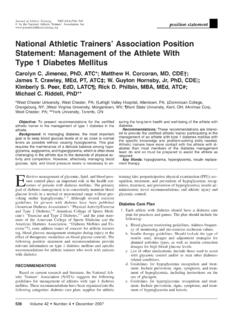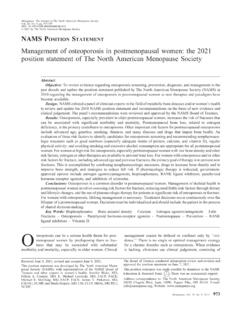Transcription of Recommended Vitamin D Intake and Management of Low …
1 Journal of Adolescent Health 52 (2013) 801e803. position statement Recommended Vitamin D Intake and Management of Low Vitamin D Status in Adolescents: A position Statement of the Society for Adolescent Health and Medicine The Society for Adolescent Health and Medicine Vitamin D de ciency is common in adolescents worldwide, When serum 25(OH)D decreases, parathyroid hormone and the list of reported detrimental health effects associated with (PTH) secretion may increase, leading to increased osteoclast this de ciency continues to grow [1]. Even subclinical de ciency activity and bone resorption. Although maximal suppression during adolescence may affect bone acquisition, potentially re- of PTH has been suggested as a way to determine suf ciency ducing peak bone mass and increasing the risk of osteoporosis in of serum 25(OH)D [8], one recent study of 735 children and later life.
2 Current evidence suggests that giving Vitamin D supple- adolescents did not show a clear in ection point for 25(OH)D. ments to adolescents who are Vitamin Dede cient may improve concentration above which PTH secretion was inhibited [9]. their bone mineral density as well as increase their total bone Although there has been an intense debate as to which mineral content [2e4]. There is also recent evidence to suggest that serum 25(OH)D concentrations are optimal for the acquisition an adequate Vitamin D Intake is associated with decreased stress and maintenance of bone mass, it is believed that serum fracture risk among physically active females [5]. Because adoles- 25(OH)D concentrations of at least 32 ng/mL (80 nmol/L) may cence is a critical period for bone mineral accrual, it is clear that be needed for optimal calcium absorption ef ciency [8].
3 Attention should be paid to the Vitamin D status of adolescents. Weaver and Fleet estimated that consumption of 1,063 IU of Vitamin D a day is necessary in order to achieve a serum Sources of Vitamin D 25(OH)D level of 32 ng/mL (80 nmol/L) in female adolescents aged 12 to 19 years [8]. In humans, the main source of Vitamin D is from cutaneous synthesis through a process initiated by incidental natural sun exposure/ultraviolet B irradiation. However, prolonged sun Society for Adolescent Health and Medicine exposure is discouraged because of the increased risk of skin Recommendations cancer, and a threshold of sun exposure suf cient to maintain a healthy Vitamin D status without measurable cancer risk is 1. Provide Vitamin D supplementation of 600 IU daily (400e800.)
4 Dif cult to de ne. The ability to synthesize Vitamin D in the skin IU daily, given preparation availability on market) for healthy varies considerably by skin type, season, and geography [6]. At adolescents, and at least 1,000 IU daily for adolescents who some latitudes, cutaneous synthesis of Vitamin D is precluded are at risk for Vitamin D de ciency or insuf ciency (Table 1), in during the winter months [6]. The use of sunscreen also almost addition to Vitamin D received through the diet or via sun completely blocks cutaneous Vitamin D synthesis [7]. Only small exposure. amounts of Vitamin D can be derived from dietary sources 2. Measure serum 25(OH)D concentration in adolescents including oily sh, eggs, and from Vitamin Deforti ed foods such who are at risk for Vitamin D de ciency or insuf ciency as dairy products and breakfast cereals.
5 Because Vitamin D is fat- (Table 1). soluble, there are manufacturing challenges encountered when 3. Consider a serum 25(OH)D concentration of 30 to 50 ng/mL. attempting to fortify food products and many beverages. Thus, (75e125 nmol/L) as optimal for adolescents. only small amounts of Vitamin D can be feasibly provided 4. Treat Vitamin D de cient adolescents [25(OH)D <20 ng/mL. through the diet. (50 nmol/L)] with 50,000 IU of Vitamin D once weekly for 8 weeks. Assessment of Vitamin D Status 5. Supplement Vitamin D insuf cient adolescents [25(OH)D. 20e29 ng/mL ( nmol/L)] with Vitamin D 1,000 IU/day Body Vitamin D stores can be assessed by measuring for at least 3 months. serum concentration of 25-hydroxyvitamin D [25(OH)D]. 6. Supplement/treat with a Vitamin D3 preparation, if this prep- aration is easily available to the patient/family.
6 position paper approved by the Society for Adolescent Health and Medicine's 7. Recommend taking Vitamin D treatment/maintenance/supple- Board of Directors, March 2013. ment with dinner. 1054-139X/$ e see front matter 2013 Society for Adolescent Health and Medicine. All rights reserved. 802 position statement / Journal of Adolescent Health 52 (2013) 801e803. Table 1 25(OH)D status. Measurement of 25(OH)D levels is recom- Indications for obtaining serum 25(OH)D measurement in adolescents mended for teens with increased skin pigmentation, adolescents Increased skin pigmentation who use sunscreens frequently, obese adolescents, and adoles- Frequent use of sunscreen cents suffering from a chronic condition known to be associated Obesity (>95th percent body mass index for age and gender).
7 With Vitamin D de ciency (Table 1). Consideration should also be Speci c diets such as vegan/macrobiotic Cultural convention associated with body coverage given to teens who have an underlying condition or receive Chronic gastrointestinal diseases that can lead to malabsorption medications that put them at risk for bone loss; the rationale is (in ammatory bowel disease, celiac disease, cystic brosis) that optimization of Vitamin D status in these patients may Amenorrhea improve their compromised bone health. Measurement of Pregnancy or lactation Immobilization (cerebral palsy, neuromuscular disease). calcium, phosphorous, alkaline phosphatase, and parathormone Following bariatric surgery should be considered when long-standing Vitamin D de ciency Chronic kidney disease is suspected.
8 Chronic liver disease Use of medications that can increase catabolism of Vitamin D such as glucocorticoids, anticonvulsants, and HIV medications Optimal Vitamin D status Recurrent fractures or known low bone mineral density status SAHM regards a serum 25(OH)D concentration of more than 30 ng/mL (75 nmol/L) as suf cient and indicative of a normal Rationale for Recommendations Vitamin D status. Because some studies have shown health risks with serum 25(OH)D concentrations of 50 to 100 ng/mL. Recommended Intake of Vitamin D for adolescents (125e250 nmol/L), SAHM regards serum 25(OH)D concentra- tion of 30 to 50 ng/mL (75e125 nmol/L) as optimal for adoles- In 2010, the Institute of Medicine (IOM) Recommended 600 IU cents. A recent systematic literature review concluded that of Vitamin D/day as dietary allowance for adolescents [10], with Vitamin D supplements were unlikely to be bene cial to the an upper level of safe Intake set at 4,000 IU of Vitamin D/day [10].
9 Skeletal health of adolescents with normal Vitamin D levels [4]. Society for Adolescent Health and Medicine (SAHM) agrees with Furthermore, existing data do not justify Vitamin D supple- these recommendations for healthy adolescents. Although there mentation in patients with suf cient Vitamin D for the purpose are some data to suggest that even higher Intake levels of up to of reducing the risk of cardiovascular disease or certain types of 10,000 IU Vitamin D/day are safe [11], care providers should be cancer. cognizant of signs of Vitamin D intoxication such as hyper- calciuria and hypercalcemia. Treatment of Vitamin D de ciency In 2011, the Endocrine Society published guidelines focusing on children, adolescents, and adults who are at risk either for SAHM agrees that the threshold for Vitamin D de ciency is a low Vitamin D status and/or a low bone mineral density [11].
10 A serum 25(OH)D level of less than 20 ng/mL (50 nmol/L), as In these guidelines, a Vitamin D supplementation dose of at least stated in the IOM report [10]. Vitamin Dede cient adolescents 1,000 IU daily is Recommended for high-risk children and ad- should be treated with 50,000 IU of Vitamin D administered with olescents. Even higher doses may be needed for adolescents with food once a week for 8 weeks. A repeat 25(OH)D measurement obesity, receiving anticonvulsants, or possessing multiple risk can be obtained at the end of treatment. A repeat course of factors known to be associated with hypovitaminosis D. Unfor- treatment may be indicated if the adolescent remains Vitamin tunately, the current mean ( SE) Vitamin D Intake from food and Dede cient.








